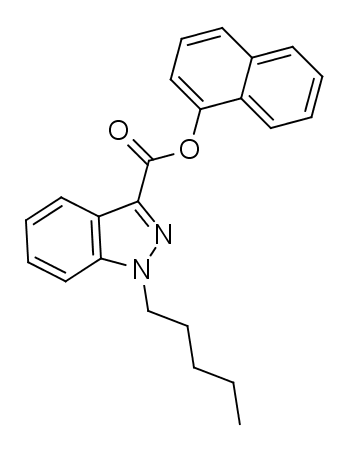Summary
SDB-005 is a synthetic cannabinoid based on the indazole structure and has been made available for purchase online as a designer drug. It is believed to act as an agonist for the CB1 and CB2 cannabinoid receptors. Notably, SDB-005 shares the indazole core with PB-22, but it distinguishes itself by replacing the 8-hydroxyquinoline with a naphthalene group.
The code designation “SDB-005” was initially assigned to a different chemical compound, precisely the N-phenyl variant, rather than the N-benzyl analogue of SDB-006. This particular compound is a potent agonist for both the CB1 receptor (Ki = 21 nM) and the CB2 receptor (Ki = 140 nM).
However, the terminology “SDB-005” was later employed to refer to the indazole-3-carboxylate compound mentioned earlier, mainly when it was distributed as a designer drug in Europe. This new usage led to the inclusion of this compound in the EMCDDA synthetic drug database under the name “SDB-005.” As a result, there are now two distinct yet closely related cannabinoid compounds, both potentially identified by the code SDB-005.
| Identifiers | |
|---|---|
| IUPAC name | |
| CAS Number | 2180934-13-6 |
|---|---|
| PubChem CID | 125181303 |
| ChemSpider | 30922481 |
| UNII | Z6XWV5U765 |
| Chemical and physical data | |
| Formula | C23H22N2O2 |
| Molar mass | 358.441 g·mol−1 |

FAQ
1. What is SDB-005?
- SDB-005 is a synthetic cannabinoid that has been used as a designer drug. It is known for its potential effects on the endocannabinoid system.
2. How is SDB-005 different from natural cannabinoids?
- SDB-005 is a synthetic compound designed to interact with cannabinoid receptors in the body. It differs from naturally occurring cannabinoids found in cannabis plants.
3. What are the effects of SDB-005?
- The effects of SDB-005 can vary widely and may include relaxation, altered perception, and mood changes. However, it’s important to note that the use of synthetic cannabinoids can also have adverse effects and health risks.
4. Is SDB-005 legal?
- The legal status of SDB-005 varies by country and region. It’s essential to be aware of the specific laws and regulations in your area regarding the possession and use of synthetic cannabinoids.
5. What are the potential risks associated with SDB-005 use?
- The use of SDB-005 may pose health risks, including adverse reactions, addiction, and unknown long-term effects. Synthetic cannabinoids can be unpredictable and harmful, so it’s crucial to exercise caution.
6. Can SDB-005 be detected in drug tests?
- Yes, SDB-005 may be detectable in drug tests designed to identify synthetic cannabinoids. It’s essential to be aware of the potential legal and employment consequences of a positive drug test result.
7. How should I use SDB-005 safely, if at all?
- It is not recommended to use SDB-005 or any synthetic cannabinoids, as their safety and effects can be unpredictable. If you have questions or concerns about substance use, it’s best to seek guidance from a healthcare professional.
8. What should I do in case of adverse reactions to SDB-005?
- If you or someone you know experiences adverse effects after using SDB-005, seek immediate medical attention. Be honest with healthcare providers about the substances used to ensure appropriate care.
9. Is there ongoing research on SDB-005?
- Research on synthetic cannabinoids, including SDB-005, continues, focusing on their pharmacology, effects, and potential health risks. It’s essential to stay updated with the latest scientific findings in this area.
10. Where can I find more information about SDB-005?
- For detailed information on SDB-005, its effects, legal status, and safety, consult reliable sources such as government health agencies, medical professionals, and substance abuse organizations.
References
- “SDB-005”. Information source: Cayman Chemical. Date of retrieval: June 27, 2015.
- In a study published in July 2013 by Banister SD, Wilkinson SM, Longworth M, Stuart J, Apetz N, English K, et al., entitled “The synthesis and pharmacological evaluation of indoles derived from adamantane: Novel cannabimimetic substances of abuse,” the synthesis and pharmacological properties of substances similar to cannabinoids were explored. This article was featured in ACS Chemical Neuroscience, Volume 4, Issue 7, on pages 1081 to 1092. You can access the study via doi:10.1021/cn400035r, and it is available in PMC with reference to PMC 3715837. The PMID is 23551277.
- Information related to “EWS_EU: Neue Psychoaktive Substanzen,” dated April 2015.